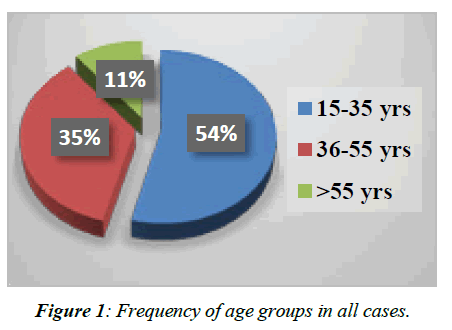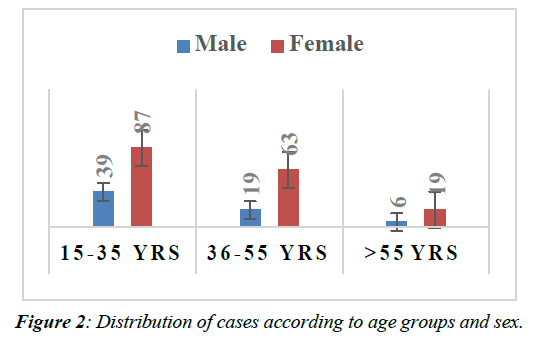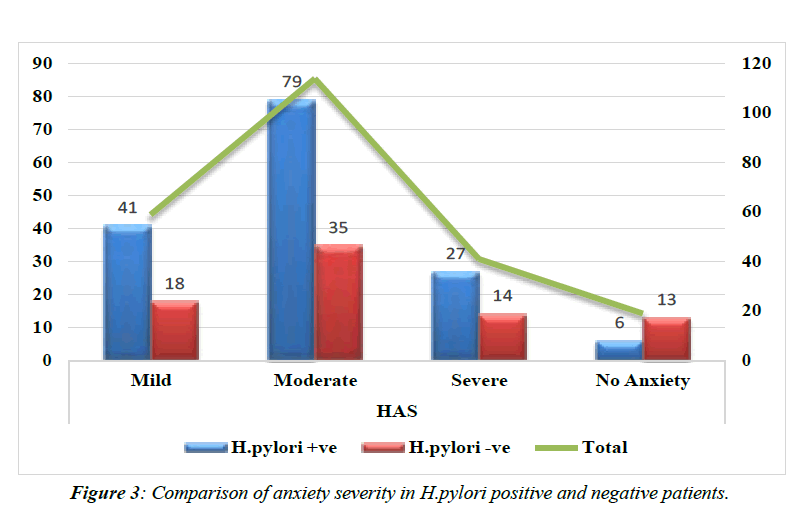Research Article - Journal of Gastroenterology and Digestive Diseases (2023) Volume 8, Issue 5
Helicobacter pylori infection association with anxiety in patients with upper gastrointestinal symptoms in Hadhramout
Ahmed M daakeek1*, Nabeel S. Musiaan1 and Ali Ahmed Al-Zaazaai21Associated Professor of medicine , Medical Department, Faculty of Medicine and Health Sciences, Hadhramout University, Mukalla, Yemen
2M.Sc. Department of Pharmacy, Wenzhou Medical University, Wenzhou, PR, China
- *Corresponding Author:
- Ahmed M daakeek
Associated Professor of medicine
Medical Department, Faculty of Medicine and Health Sciences
Hadhramout University, Mukalla, Yemen
E-mail: daakeek@gmail.com
Received: 29-June-2023, Manuscript No. JGDD-23-109844; Editor assigned: 03-July-2023, Pre QC No. JGDD-23-109844 (PQ); Reviewed: 17-July-2023, QC No. JGDD-23- 109844; Revised: 19-July-2023, Manuscript No. JGDD-23-109844 (R); Published: 26-July-2023, DOI: 10.35841/ jgdd -8.5.161
Citation: Daakeek A M, Helicobacter pylori infection association with anxiety in patients with upper gastrointestinal symptoms in Hadhramout. J Gastroenterol Dig Dis. 2023;8(5):161
Keywords
H. pylori infection, HAS score, Anxiety.
Introduction
Helicobacter pylori (H. pylori) is Gram-negative and spiral, and has multiple flagella at one end, which make it motile, allowing it to burrow and live beneath the mucus layer adherent to the epithelial surface [1]. The prevalence of H. pylori is high in developing countries (80–90% of the population) and much lower (20–50%) in developed countries.
Infection rates are highest in lower-income groups. Infection is usually acquired in childhood; although the exact route is uncertain, it may be faecal–oral or oral–oral [2]. The vast majority of colonized people remain healthy and asymptomatic, and only a minority develop clinical disease [1]. H. pylori infection has been recognized as the main risk factor for many upper digestive tract disorders and complications, including life-threatening bleeding from the digestive tract, gastritis, non-ulcer dyspepsia, Mucosa-Associated Lymphoid Tissue (MALT) lymphoma and gastric cancer [3].
The presence of H. pylori-negative upper digestive tract abnormalities, such as peptic ulcers and the fact that not all H. pylori-infected patients develop ulcers, with only 10%- 15% of them presenting dyspeptic symptoms[3], suggest a role for other individual factors, including nervous system imbalance, as an indispensable cofactor in gastritis or ulcer disease pathogenesis [4].
These imply that H. pylori infection may induce changes in the function and morphology of the digestive tract both directly through cytotoxin release and inflammatory process activation, and indirectly, via the brain-gut axis [5]. Gut-brain axis is defined as the relationship of gastrointestinal with brain function and mental status. Mental stress is associated with personality-dependent gastric acid secretion changes [6]. Moreover, gastric inflammation leads to anxiety and depression-like behaviors via the neuroendocrine pathways especially in female [7].
There are several Studies have reported that the change in the gut microorganisms could cause emotional disturbances, behavioral changes as well as mental health problems, but the mechanism is still under investigation [8].
This study aims to estimate the relations of H.pylori infections to the psychiatric manifestation in patients with upper gastrointestinal symptoms and the frequency of anxiety in those patients.
Materials and Methods
This study conducted in private medical center in Mukalla city the capital of Hadhramout governorate and the center of all eastern governors of Yemen, which include Shabowa, Mahra and Scotora besides Hadhramout, and all this four governorates called Hadhramout sector, so it is a reference city for many cases that come and transferred from these governors for treatment.
This prospective study included 233 adult patients with Upper GastroIntestinal Tract (UGIT) symptoms who visited the medical outpatient between August 2022 and February 2023 (n=223), examined the connection between H. pylori infection and anxiety symptoms.
A specially designed Performa with four sections was used for data collection. Section one contains demographic details including age, gender and residence. All patients aged 15 years or older were included. The age is further grouped in decades to three age groups: 15–35, 36–55, and above 55 years.
The second section inquired about the details of a clinical profile including UGIT symptoms which were defined at least two or more of the following symptom: epigastric pain or epigastric burning symptoms, retrosternal pain, heartburn, regurgitation, nausea and vomiting, early satiation, and postprandial fullness, and for the last 2 weeks.
The third section consists of the Hamilton Anxiety Scale (HA) assessment of anxiety, which is used to assess the severity of anxiety symptoms. The scale consists of 14 items; each item contains a number of symptoms, and each item is graded from zero to four according to severity. The results of the evaluation are reading as; mild severity =17 or less, moderate =18-24, and severe = 25-30.
Fourth section records investigation primarily H.pylori infection by detection of stool antigen using Rapid Pylori Antigen (TRP) immunochromatography kit, as per manufacturer's instructions. The overall sensitivity is 97.6% and specificity is 96% [2]. The test is useful in the diagnosis of H. pylori infection and for monitoring efficacy of eradication therapy; it is a cheap and easy method for the initial diagnosis of H. pylori infection. The patients were divided into two groups based on the presence or absence of H. pylori infection: H. pylori positive and H. pylori negative groups. All cases were undergoing ultrasonographic imaging procedures to exclude biliary, pancreatic, and other diseases. Upper endoscopy was not done in almost all cases.
Data were analyzed using statistical software SPSS version 23, and Microsoft Office Excel. Descriptive statistics of demographic variables were calculated including frequencies, percentages, means and ranges. Patient’s characters were compared using the Chi square test. A1-sided p<0.05 was considered statistically significant at the 95% confidence level.
Ethical consent
The College of medicine - Hadhrmout University (HUCOM), authorized the protocol for this study. All study participants gave their written consent after being informed of the objectives of our investigation.
Results
The study included 233 patients with upper gastrointestinal symptoms, ranging in age from 15 to 73 years and mean age was 35.03 years (SD ± 13.732), The majority of these patients were in age group of 15-35 years old (n=126, 54.1%),followed by age group 36-55 years (n=82, 35.2%), and both constitute 89.3% of all cases, while older than 55 years age group considered the last group, as shown in (Figure 1), and there is significant correlation between age and H.pylori status (p value 0.012). The majority of cases being females (n=169, 72.5%) with female to male (ratio 2.6:1), the distribution of cases according to sex and age groups depicted in (Figure 2).
Most of the cases from Hadhramout governorate (n=154, 66.1%), followed by Mahra governorate (n=47, 20.2%), Shabowa governorate (n=26, 11.2%) and Socotra governorate the last (n=6, 2.6%).
All cases exhibit at least two symptoms of UGIT, and epigastric pain or epigastric burning symptoms are the most prevalent symptoms constitute 97.4% (n=227) of cases, while other symptoms are less frequent. (Table 1) list the most frequent symptoms of anxiety according to HAS in relation to H.pylori status including fear, insomnia, cardiovascular, respiratory, and gastrointestinal symptoms which were the most common.
| Anxiety Items | H.pylori +ve | H.pylor-ve | ||
|---|---|---|---|---|
| No | % | No | % | |
| Worries | 115 | 80.4 | 52 | 77.6 |
| Tension | 88 | 61.5 | 32 | 47.8 |
| Fears | 132 | 93.3 | 61 | 91 |
| Insomnia | 129 | 90.2 | 60 | 89.6 |
| Difficulty in concentration | 88 | 61.5 | 33 | 49.3 |
| Depressed mood | 47 | 32.9 | 24 | 35.8 |
| Somatic (muscular) | 26 | 18.2 | 15 | 22.4 |
| Somatic (sensory) | 36 | 25.2 | 16 | 23.9 |
| Cardiovascular symptoms | 127 | 88.9 | 59 | 88.1 |
| Respiratory symptoms | 124 | 86.7 | 56 | 83.6 |
| Gastrointestinal symptoms | 123 | 86 | 54 | 80.6 |
| Genitourinary symptoms | 28 | 19.6 | 12 | 17.9 |
| Autonomic symptoms | 37 | 25.9 | 16 | 23.9 |
| Behavior at interview | 12 | 8.4 | 5 | 7.5 |
Table 1: Anexiety symptom frequency in relation to H.pylori status.
A majority of the cases (n=163, 65.7%) were H. pylori positive, with females accounting for the bulk of cases (n=113, 56%). Nearly half of the cases (51.3%) were in the 15–35 age range. Although there were 34.3% (n=80) H. pylori negative patients, the majority of them were female and belonged to the same age group. (Table 2) displays the distribution of cases by age groups sex, and H. pylori status.
| Age group | H.pylori +ve | H.pylori -ve | Total cases | ||||
|---|---|---|---|---|---|---|---|
| Male | Female | Total | Male | Female | Total | ||
| 15-35 years | 26 | 58 | 84 | 13 | 29 | 42 | 126 |
| 36-55 years | 14 | 45 | 59 | 5 | 18 | 23 | 82 |
| > 55 years | 0 | 10 | 10 | 6 | 9 | 15 | 25 |
| Total | 40 | 113 | 153 | 24 | 56 | 80 | 233 |
Table 2: Distribution of H. pylori cases according to age groups and sex.
We employed the HAS questionnaire in the study to examine the level of anxiety in our cases, and we discovered that 214 of them (91.8%) had anxiety of varying severity. Of the 147 individuals with H. pylori positivity who had anxiety status, n= 79, or 55.2%, had moderate anxiety (n=41, 27.9%) had mild anxiety, and (n=27, 18.4%) had severe anxiety. With a p value of 0.013, there is a significant association between anxiety and H. pylori infection. In contrast, among the 80 cases in which H. pylori negative , anxiety was present in 66 (82.5%) patients, the majority of whom had moderate intensity ((n=35, 43.8%), whereas moderate and severe anxiety were less common (22.5% and 17.5%, respectively). The level of anxiety in both H. pylori groups is shown in (Figure 3).
Discussion
H. pylori prevalence is higher in our country and is detected in patients with esophagitis, gastritis and peptic ulcer diseases as well as asymptomatic patients [9-11], and there is a relation between it and psychiatric manifestations in some studies [12, 13]. In this study, we try to investigate the association between H.pylori and anxiety in 233 patients presents with UGIT manifestations.
In this study, Hadhramout governarates accounted for 66.1% of the cases. While Mahra, Shabow, and Scotra governments are less frequent, this is primarily because of their far distance from Mukalla, particularly Socotra, which is an island and has no other means of transport outside flights and boats, as well as their higher cost given the country current economic situation.
The majority of H. pylori cases were females, which is consistent with research conducted in our country [9, 10], as well as in Bahrin, Saudi Arabia, Egypt, Iran, and other nations in the Eastern Mediterranean region [5, 7, 13-16]. The age range 15-35 years was the most prominent and the most affected age group was under 55 years old, according to several research conducted in Yemen and its neighboring countries [5,13-17].
No matter whether a patient had H. pylori or not, the most prevalent presenting symptom in almost all cases was epigastric pain resembling other studies [18]. While the most common symptoms of anxiety were fear and insomnia in 93.3% and 90.2% of all anxiety-related H. pylori positive patients, respectively.
Our study demonstrates that patients with confirmed H. pylori infections have higher rates of anxiety than negative cases, with female patients being more likely to experience this. This finding is consistent with studies from Yemen [18], Bahrain [5], Saudi Arabia [16], and other countries that have also confirmed a connection between H. pylori and stress and anxiety [19-21].
The relationship between psychiatric disorders and H.pylori infection has been studied, and most patients in this research had some sort of anxiety with (26.8%) having mild Anxiety, (51.6%) moderate Anxiety, and (17.6%) severe Anxiety, while those without anxiety constitute about (3.9%) of all cases. This study finding was supported by some studies that discovered a strong positive relationship between H. pylori presence and anxiety symptoms [6, 22]. Additionally, numerous studies have shown that the elimination of H. pylori alleviates UGIT symptoms [23-25]. However, other research, like as the Kivrak, Y., et al. study, [26], disputes the relationship between the two.
H.pylori negative cases make up less percentage 34.3% than positive cases, there is considerable cases having anxiety, and this may attributable to infection and stress rather than H.pylori infection.
H. pylori negative patients make up a smaller fraction (34.3%) than positive cases. There are many cases of anxiety for them, which may be caused by stress and fear of infection rather than H. pylori infection.
In an intriguing approach, our research found that the positive H. pylori group had a highly significant rise in moderate and severe anxiety when compared to the negative H. pylori group.
Conclusion
Hadhramout and Yemen in general have a high rate of H. pylori infection, mostly in female patients under 55 years old, and a high rate of H. pylori infections associated with moderate to severe anxiety. Therefore, an evaluation of presence anxiety is crucial in patients with gastrointestinal symptoms and symptoms of dyspepsia.
References
- Penman ID, Ralston SH, Strachan MW, et al. Davidson's Principles and Practice of Medicine E-Book. Environ Health; 2022.
- Kumar P, Clark ML. Kumar and Clark's clinical medicine E-Book. Elsevier sci; 2012.
- Malfertheiner P, Megraud F, O'Morain CA, et al. Management of Helicobacter pylori infection—the Maastricht IV/Florence consensus report. Gut. 2012;61(5):646-64.
- Chen TS, Chang FY. Clinical characteristics of Helicobacter pylori-negative duodenal ulcer disease. Hepatogastroenterology. 2008;55(86-87):1615-8.
- Nada Ali Mohamed and Nashwa Fawzy Abd El Moez Azzam. Helicobacter pylori Associated Psychiatric Disorders among Bahraini Adult Presenting with Function Dyspepsia. Journal of Medical Sciences, 20:(2020). 55-59.
- Goodwin RD, Talley NJ, Hotopf M, et al. A link between physician-diagnosed ulcer and anxiety disorders among adults. Ann Epidemiol. 2013;23(4):189-92.
- Agah S, Khedmat H, Ghamar-Chehred ME, et al. Female gender and Helicobacter pylori infection, the most important predisposition factors in a cohort of gastric cancer: A longitudinal study. Caspian J Intern Med. 2016;(2):136.
- Heijtz RD, Wang S, Anuar F, et al. Normal gut microbiota modulates brain development and behavior. Proc Natl Acad Sci. 2011;108(7):3047-52.
- Al-Makdad AM, Al-Dholaee MH, Thabet AA, et al. Prevalence of Helicobacter pylori infection in Yemeni patients. Yemeni J Med Sci. 2013;(1):33-8.
- Almashhadany DA, Mayass SM. Prevalence of Helicobacter pylori in Human in Dhamar governorate/Yemen. مجلة العلوم الطبية و الصيدلانية. 2018;(1):18-.
- Alyahawi A, Alkaf A, Alzaghrori S. Prevalence of helicobacter pylori among asymptomatic populations in Sana'a, Yemen. Uni J Pharma Res. 2018;3(3):31-5..
- Budzyński J, Kłopocka M. Brain-gut axis in the pathogenesis of Helicobacter pylori infection. World J Gastroenterol. 2014;20(18):5212.
- Piriyapong K, Tangaroonsanti A, Mahachai V, et al. Helicobacter pylori infection impacts on functional dyspepsia in Thailand. Asian Pac J Cancer Prev. 2014;15(24):10887-91.
- Mohamed DM, Elrassas H. Helicobacter Pylori Associated Depression among Patients Presenting with Epigastric Pain. Egypt J Hosp Med. 2023;90(2):2315-20.
- Eshraghian A. Epidemiology of Helicobacter pylori infection among the healthy population in Iran and countries of the Eastern Mediterranean Region: a systematic review of prevalence and risk factors. World J Gastroenterol. 2014;20(46):17618.
- Akeel M, Elmakki E, Shehata A, et al. Prevalence and factors associated with H. pylori infection in Saudi patients with dyspepsia. Electron Physician. 2018;10(9):7279.
- Marie MA. Alimentary tract: Seroprevalence of helicobacter pylori infection in large series of patients in an urban area of Saudi Arabia. 대한소화기학회지. 2008;52(4):226-9.
- Gunaid AA, Hassan NA, Murray-Lyon I. Prevalence and risk factors for Helicobacter pylori infection among Yemeni dyspeptic patients. Saudi Med J. 2003;24(5):512-7.
- Levenstein S, Kaplan GA, Smith MW. Psychological predictors of peptic ulcer incidence in the Alameda County Study. J. Clin. Gastroenterol. 1997;24(3):140-6.
- Nguyen T, Ramsey D, Graham D, et al. The Prevalence of H elicobacter pylori Remains High in African American and Hispanic Veterans. Helicobacter. 2015;20(4):305-15.
- Levenstein S. The very model of a modern etiology: a biopsychosocial view of peptic ulcer. Psychosom Med. 2000;62(2):176-85.
- Cader J, Domagala Z, Paradowski L, et al. Is there any relation of Helicobacter pylori infection to anxiety and depressive symptoms?. Gastroenterologia Polska. 2007;14(6):397.
- Kabeer KK, Ananthakrishnan N, Anand C, et al. Prevalence of Helicobacter pylori infection and stress, anxiety or depression in functional dyspepsia and outcome after appropriate intervention. J Clin Diagnostic Res. 2017;11(8):VC11.
- Sodhi JS, Javid G, Zargar SA, et al. Prevalence of H elicobacter pylori infection and the effect of its eradication on symptoms of functional dyspepsia in K ashmir, India. J Gastroenterol Hepatol. 2013;28(5):808-13.
- Tennant C, Goulston K, Langeluddecke P. Psychological correlates of gastric and duodenal ulcer disease. Psychol Med. 1986;16(2):365-71.
- Kivrak Y, Kokacya H, Copoglu US, et al. Does Helicobacter Pylori Cause Psychiatric Symptoms in Dyspeptic Patients?. Acta Medica. 2014;30:1271.
Indexed at, Google Scholar, Cross Ref
Indexed at, Google Scholar, Cross Ref
Indexed at, Google Scholar, Cross Ref
Indexed at, Google Scholar, Cross Ref
Indexed at, Google Scholar, Cross Ref
Indexed at, Google Scholar, Cross Ref
Indexed at, Google Scholar, Cross Ref
Indexed at, Google Scholar, Cross Ref
Indexed at, Google Scholar, Cross Ref
Indexed at, Google Scholar, Cross Ref
Indexed at, Google Scholar, Cross Ref
Indexed at, Google Scholar, Cross Ref
Indexed at, Google Scholar, Cross Ref
Indexed at, Google Scholar, Cross Ref
Indexed at, Google Scholar, Cross Ref


